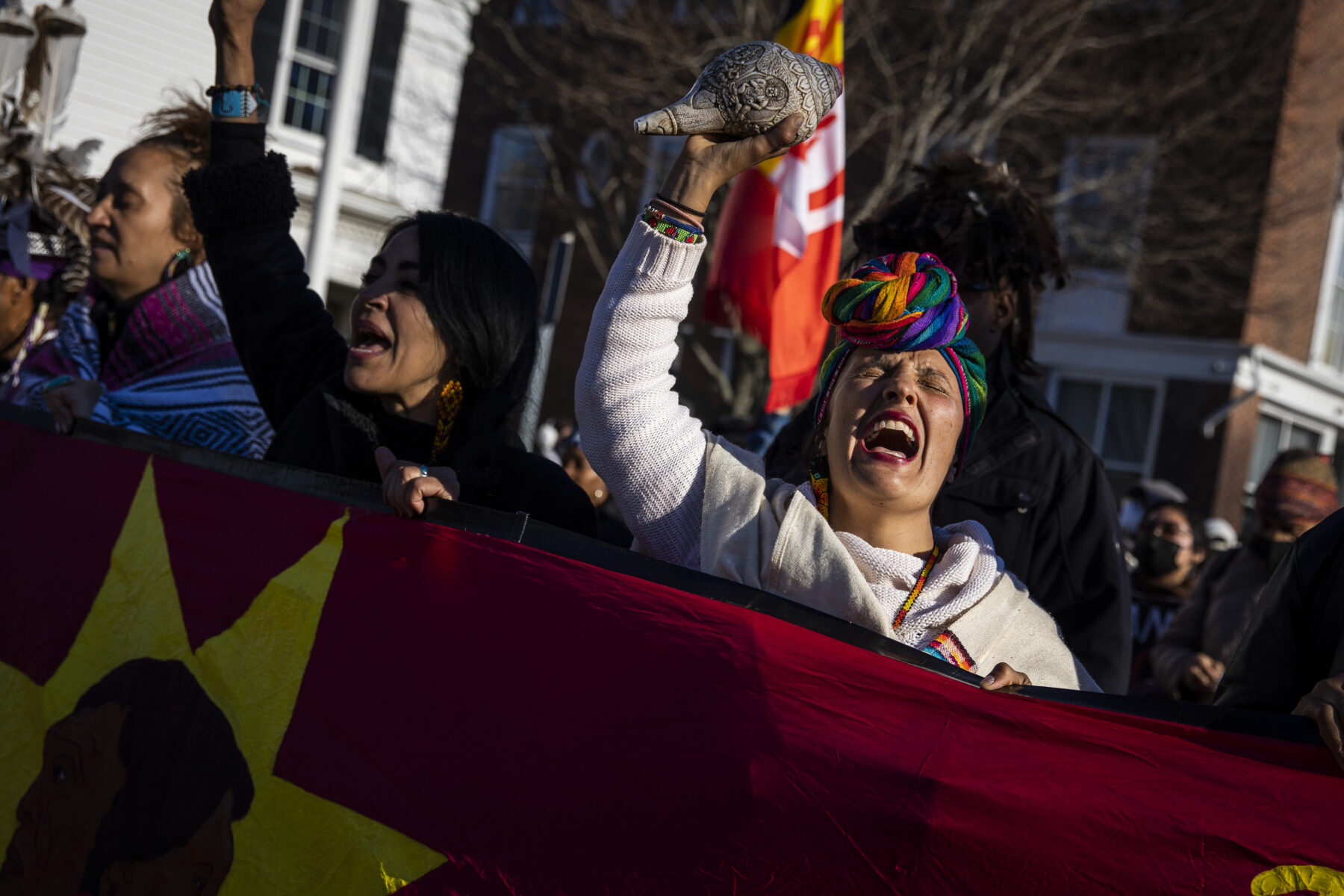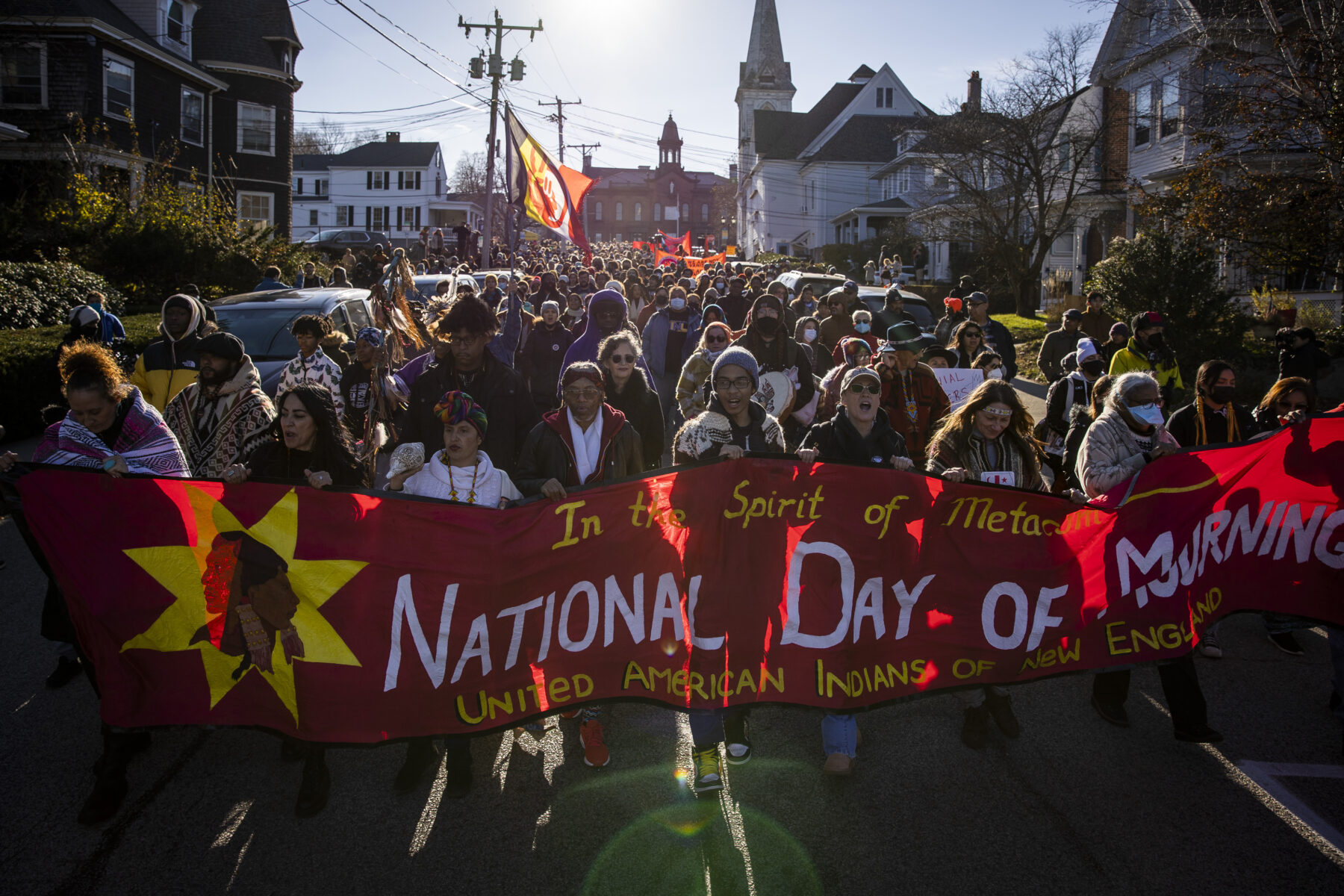
Thanksgiving news coverage is often relegated to lighter fare: an unexpected family reunion, a new trend in casseroles, maybe a travel story about gas prices and airplane delays to add some punch. But Thanksgiving isn’t a day of joyful family gatherings for everyone. For Native tribes in New England, it’s a National Day of Mourning; for many more Indigenous people, it’s a reminder of how little the country regards them, their culture and their history.
Below, two journalism students from the Institute of American Indian Arts share how the media can better cover Indigenous people — not just during the Thanksgiving holiday, but every day.
A week before Thanksgiving, my fourth-grade teacher, Mrs. Martinez, put on a video about Thanksgiving from the animators of “Peanuts.” As “A Charlie Brown Thanksgiving” played for 25 minutes in our homeroom, we watched the Indians support the pilgrims and share a meal. I remember the ads for Black Friday airing the same week, convincing my mom that she needed a cheap television or luxury massage chair. Then there were the news anchors describing the gratitude at the center of the holiday, as footage of the Macy’s Thanksgiving Day Parade played behind them.
Many of us learn about Thanksgiving as a get-together between different people who have learned to cooperate on the same land and give thanks for their help. We take from this telling the general gratefulness we should feel toward family and friends, avoiding the true history of violence and devastation perpetrated by visitors who claimed the land as their own.
Today, most news outlets still don’t cover Thanksgiving the way most Natives know it: a time of grieving and remembrance of brutal centuries past. Many see it as the time to eat turkey, mashed potatoes and canned cranberries, then settle into watching football. Stories on the news often present feel-good family features, pie recipes and American traditions.
But the news doesn’t have to be this way. It could instead focus on the accurate history surrounding the holiday.
Here is some background: The people we know as the “pilgrims” were called the Separatists, a stricter sect of the English Puritans. They left England because King James disliked their extremist views, which threatened his title and prowess. On their way to Jamestown, Virginia, in the “New World,” their ship, the Mayflower, veered off course and landed in modern-day Plymouth, Massachusetts, in 1620.
A few years prior, a nearby Patuxet village had been wiped out by infectious diseases from other European expeditions. Historians agree that when Tisquantum — a member of the Patuxet band of Wampanoag — returned home to the village after being trafficked to Europe, he discovered his people were killed. Tisquantum was the only Patuxet alive. Having learned English from his time in Europe, Tisquantum (who was nicknamed Squanto by the colony’s governor) acted as a diplomat between the Separatists and the Wampanoag. He taught them to cultivate the three sisters — corn, beans and squash — though they still struggled. In many stories, Tisquantum’s agricultural knowledge leads to a feast, often noted as the first “Thanksgiving.” He died in 1622 on a boat, sick from “Indian fever.”
This is, of course, a grossly shortened summary of the events, but it paints a clearer picture than the chicken scratch that other Thanksgiving mythos make.
Journalists, though, have the power to shift the narrative. In addition to the latest turkey recipes, journalists should include accurate historical context in their reporting. In addition to capitalist stories of Black Friday sales, journalists should cover more acts of service and those who might not have a Thanksgiving feast. Anchors should highlight modern Indigenous practices and the gatherings that go beyond the annual Thanksgiving many Americans know. Reporters should seek out the perspectives and voices of Indigenous people, not just during the Thanksgiving holiday but all year long.
Journalists have the responsibility to tell the truth and make sense of the whole world around them. This isn’t a matter of dampening holiday fun — many Natives have not had the privilege to think of Thanksgiving as a time of gathering in joy. Rather, it’s a matter of principle. People deserve to know the real reason why Thanksgiving exists. If Columbus Day can be recognized as Indigenous Peoples’ Day by the president of the United States, then why can’t journalists do more to point out the historical wrongs of Thanksgiving?
— Rhyka Nelson

Thanksgiving is a sad day for Indigenous people. Many of us find it ironic to celebrate the idea of generosity when we see where generosity has gotten us.
For many Indigenous tribes, giving thanks is something we do regularly — we are thankful to the Earth and all it provides us. But when a lot of us think of “Thanksgiving,” instead of pumpkin pie and Black Friday, many reflect on the attempted genocide and reintegration of our people into society. We think about Christian boarding schools, smallpox blankets and the massacre of women and children at Sand Creek. These are all things the collective consciousness of America has chosen to ignore over the last 403 years. Asking us to participate in the yearly American giving of thanks is humiliating when we don’t have most of the land our ancestors were thankful for. The highest thanks we can give is to our survival.
The reality is that many Indigenous kids today know more about the country that massacred them than they know about themselves. We’ve been fed a narrative through the media for years about how Indigenous peoples were uncivilized and should be thankful we’ve been colonized. For decades we were portrayed as subhumans in film — from Disney’s “Peter Pan” and “Pocahontas” to nearly every American Western movie. One news outlet is no better — in the last presidential election, we were described as “something else” outside of Black, Latino and Asian American racial groups.
Moving forward, we as a society need to take more time to educate the public about the real history of this country. We need to move past this enigmatic image of Indigenous people as the savages who survived. Rather than just being a pre-Christmas holiday or day off from work, Thanksgiving needs to be a day of Indigenous recognition and appreciation. And journalists can help make this happen.
It would start with highlighting our contributions to society. Journalists can cover how Indigenous people have long embraced the holistic approaches to health that many find trendy today, such as focusing on the relationship between our emotional, spiritual, physical and mental well-being. Our approach to organized society was also greatly advanced — our constitutions and treaties influenced what American legislation is based on — and yet we still have little representation in government, something journalists can continually highlight. Indigenous people also bore the harsh terrain of North America when more “advanced civilizations” were unable to — journalists can cover how our practices, like controlled burning to prevent wildfires, offer lessons much of the West could learn from.
Above all, our greatest contribution is our great love for our Earth. In a time when climate change is pummeling us, journalists can spend time with Indigenous communities to offer solutions on a way forward. The gratitude we all share for the opportunity to experience the great beauty of life on this planet — that is what we are most thankful for.
— Kendrick J. Whiteman Jr.
Rhyka Nelson and Kendrick J. Whiteman Jr. are students at the Institute of American Indian Arts, a partner school of NBCU Academy.


